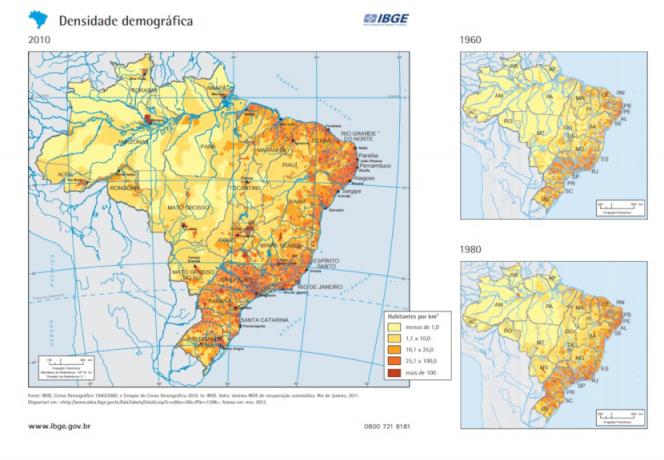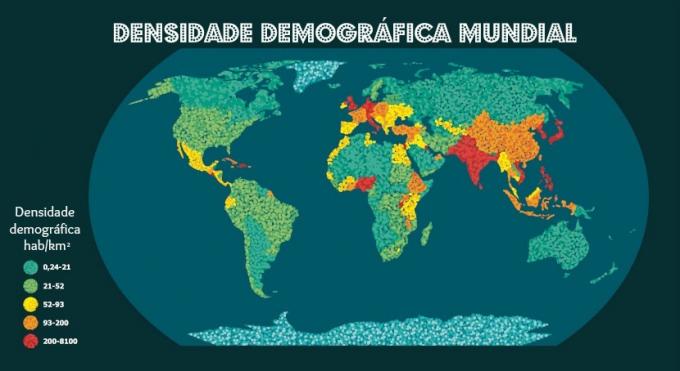Demographic densityit is an index also known as population density or relative population. It refers to the distribution of inhabitants in a given area, that is, it is the average resulting from the division between the total number of inhabitants and the occupied area.
How to calculate population density?
Demographic density is expressed in inhabitants per square kilometer (inhabitant/km²). To reach the average, it is necessary to divide the absolute population (total population) by the territorial extension of the place in question.

See below the calculation of the demographic density of the United States:
- Total inhabitants: 325,719,178
- Area: 9,371,175 km2
325.719.178 = 34.75 inhab/km2
9.371.175
The demographic density of the United States indicates that there are approximately 34.75 inhabitants per square kilometer.
populous and populated
populous and populated are two important concepts for understanding population density. A place or country is populous when it has a high number of inhabitants, that is, a large absolute population (total number of inhabitants).
the term town it represents the distribution of the population in a given place, therefore, it comprises the relationship between the number of inhabitants and the area in square kilometers. According to the average obtained through the calculation of population density, a place can be very or little populated.
To learn more about this subject, read the text: Difference between populated and populated.
Demographic density in Brazil
In Brazil there are approximately 209.3 million inhabitants, distributed in an area of 8,516,000 km2. See below how to calculate the Brazilian demographic density:
- Total inhabitants:209.300.000
- Area:8,516,000 km2
209.300.000 = 24.57 inhab/km2
8.516.000
Therefore, population density indicates that there are around 24.57 inhabitants per square kilometer.
Despite Brazil being a populous country, its continental extension makes it sparsely populated. We can find Brazilian regions that are heavily populated and others that are sparsely populated.
Read too:Is Brazil a country of continental dimensions?
→ Greater demographic density in Brazil
The Federal District has the highest demographic density in the country: 525.86 inhabitants/km2,with a population of 3,039,444 inhabitants and a total area of 5,779 km2. Next is the state of Rio de Janeiro, with a population density of 381.87 inhab/km2, and São Paulo, with 181.67 inhab/km2.
Demographic Density Map of Brazil

The demographic density map allows us to infer that the Brazilian population is mainly concentrated in coastal regions.
Source: IBGE
The map released in 2010 by the Brazilian Institute of Geography and Statistics (IBGE) based on data obtained through the 2010 Demographic Census, which depicts the spatial distribution of the Brazilian population, reveals huge disparities in the concentration of inhabitants in each region of the country. The identification on the map is of very low demographic density (1 inhab/km2) to high population density (above 100 inhab/km2).
The analysis of this map allows us to identify some characteristics regarding the Brazilian demographic density. Are they:
- A population in Brazil it is mainly concentrated in the coastal strip, so the interior regions are less populated.
- The highest demographic densities in Brazil are found around São Paulo, Rio de Janeiro, Distrito Federal and coastal areas.
- The presence of the capital of Brazil in the center of the country is also responsible for the concentration of more densely populated areas.
- The regions close to the capitals show greater demographic density in relation to other areas of the states.
- The lowest demographic densities are found in the interior, mainly in the North, Center-West and Northeastern interior regions. This occurs as a result of factors of a natural order, such as climate and large presence of vegetation cover, agricultural activities and also due to the process of occupation of these regions.
Know more:Brazilian population growth
World demographic density
According to data provided by the World Bank, there are currently around 7.3 billion inhabitants in the world. The total area of the planet is approximately 134,940,000 km2. Thus, the global demographic density is approximately 50.79 inhab/km2.

The population density map shows population distribution and concentration in the world.
Among the continents, Asia is the one with the highest population density, followed by Europe.
Know more:How is the world population distributed?
Check the demographic density of each continent in the table below:
Continent |
Information |
Africa |
Population: 1,225,080,510 Area 30,221,532 km2 Demographic density: 40.5 inhab/km2 |
America |
Population: 902,892,047 Area: 42,189,120 km2 Demographic density: 21.40 inhab/km2 |
Asia |
Population: 4,462,676,731 Area: 43,810,582 km2 Demographic density: 101.86 inhab/km2 |
Europe |
Population: 741,447,158 Area: 10,180,000 km2 Demographic density: 72.8 inhab/km2 |
Oceania |
Population: 40,117,432 Area: 9,008,458 km2 Demographic density: 4.45 inhab/km2 |
What is the most populated country in the world?
Monaco is the most populated country in the world. With a population corresponding to 37,731 inhabitants and a land area of 2 km2, has a demographic density around 18,865 inhabitants per km2.
Mongolia is the least populated country. With a total population of 2,959,134 inhabitants and an area of 1,564,120 km2, has a demographic density of approximately 1.9 inhabitants per km2.
Most populous countries in the world
The most populous countries are those that have a large number of inhabitants. Below is a list of the six most populous countries in the world:

China is the most populous country in the world, however it is not the most populated.
1) China
Total inhabitants: 1,372,470,000
Demographic density: 139.6 inhab/km2
2) India
Total inhabitants: 1,278,160,000
Demographic density: 329 inhab/km²
3) United States
Total inhabitants: 325,719,178
Demographic density: 33 inhab/km2
4) Indonesia
Total inhabitants: 255,780,000
Demographic density: 126 inhab/km2
5) Pakistan
Total inhabitants: 209,156,000
Demographic density: 206 inhab/km2
6) Brazil
Total inhabitants: 207,660,929
Demographic density: 23.8 inhab/km2
Urbanization and demographic density
One of the factors that influence the demographic density of a given place is the urbanization, which corresponds to the increase of the urban population in relation to the rural population. Areas with a predominance of mechanized agricultural activities have a low population concentration. On the other hand, areas that stand out in industrial and commercial activities tend to have greater demographic density, as people move to places that are favorable to work.
There are still other issues that influence the concentration or not of the population in a given location. Natural order factors, such as climate, vegetation, relief and water availability are determinants of population distribution.
Typically, people tend to concentrate in regions with temperate climates, in plateaus, plains and in regions that favor agriculture. In regions where the climate is very hot or very cold, there is usually a low population concentration when compared to temperate climate regions. Areas with dense vegetation, such as the Amazon, also have low population density. Historical factors, such as land occupation processes, also influence the concentration of people in a given place.
read more: Brazilian urbanization
Exercises on demographic density
1- (UEL-PR) The world population is concentrated mainly in underdeveloped countries, although some developed ones are among the most populous. In absolute terms, what is the most populous continent?
a) Oceania
b) Asia
c) Europe
d) Africa
e) America
Answer: Letter b
Asia is the most populous continent, with a population density of 101.86 inhab/km2.
2- (Vunesp) Although Brazil is ranked among the most populous countries in the world, when its total population is related to the country's area, a relatively low number is obtained. This relationship of population x area, we give the name of:
a) Growth rate.
b) Development index.
c) Demographic density.
d) Birth rate.
e) Fertility rate.
Answer: Letter c

